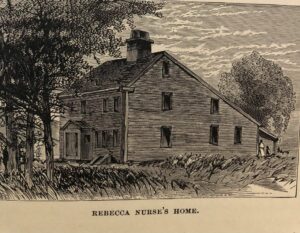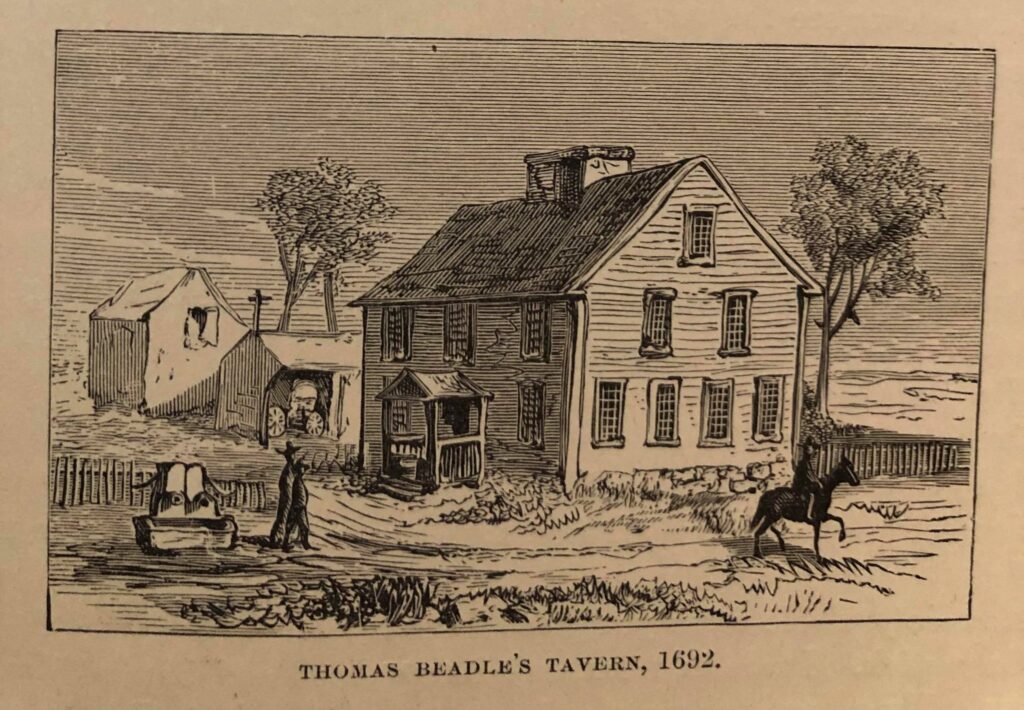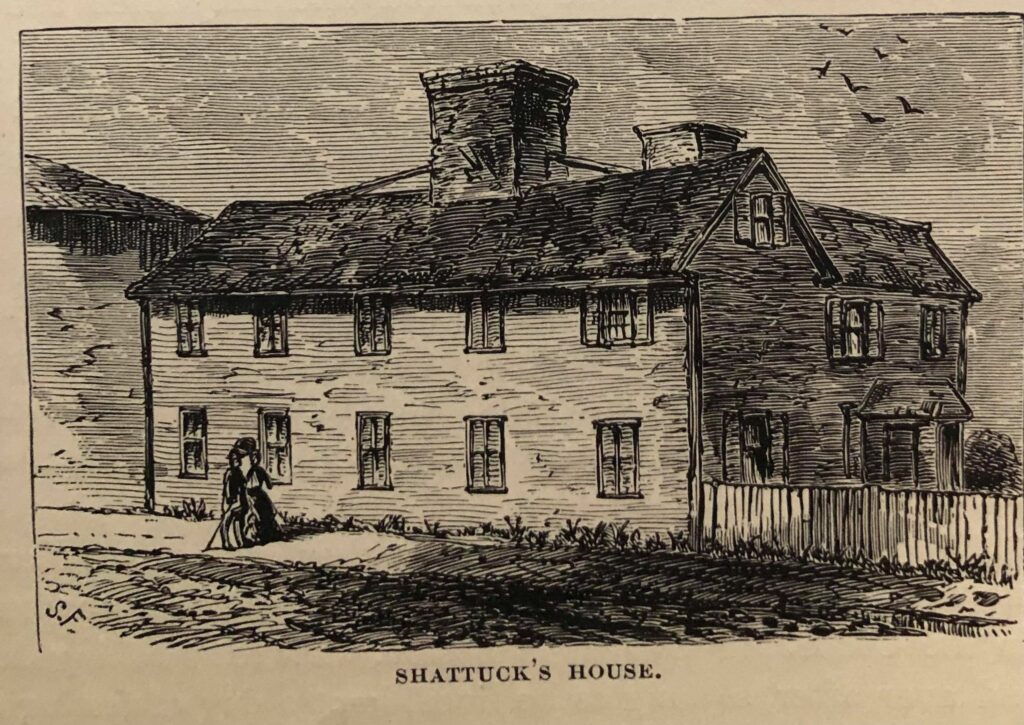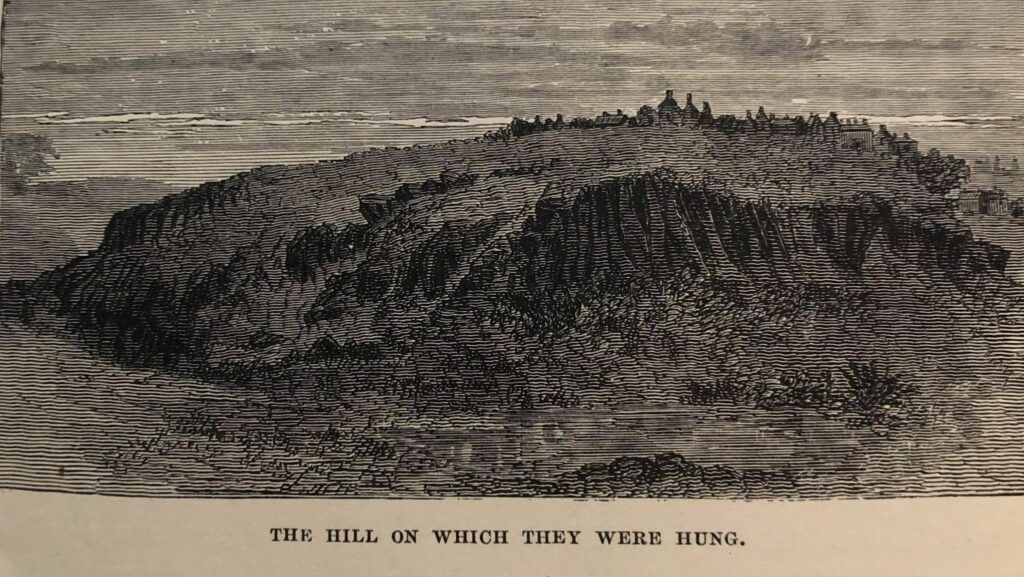 SALEM MASSACHUSETTS
SALEM MASSACHUSETTS
The saddest story in the history of the country is that of the witch craze at Salem, Massachusetts, brought about by a negro woman and company of girls. The negress, Tituba, was a slave, whom Rev Samuel Parris, one of the ministers of Salem, had purchased in Barbados. We may think of Tituba as seated in the old kitchen of Mr. Parris’s house during the long winter evening, telling witch stories to the minister’s niece, Elizabeth, who was nine years old. She draws a circle in the ashes on the hearth, burns a lock of hair, and mutters some gibberish. They are incantations to call up the devil and his imps. The girls of the village gather in the old kitchen to hear Tituba’s stories, and to mutter words that have no meanings. The girls were Abigail Williams, who was eleven, Anne Putnam who was twelve, Mary Walcot,and Mary Lewis who were seventeen, Elizabeth Hubbard, Elizabeth Booth, and Susannah Sheldon, eighteen, and two servant girls, Mary Warren and Sarah Churchill. Tituba taught them to bark like dogs, mew like cats, grunt like hogs, and to creep through chairs and under tables on their hands and feet, and to pretend to have spasms.
Mr. Parris had read the books and pamphlets published in England, how persons bewitched acted like animals, and went into spasms, and he came to the conclusion that they were bewitched. He sent for Doctor Griggs, who said that the girls were not sick, and without doubt were bewitched.
THE TOWN WAS ON FIRE!
People came to see the girls, who delighted with the success of their play, crept about all the more like cats and dogs, barking, mewing, and uttering piercing screams.
Sunday came, and when the congregation had finished singing, Abigail Williams said to Mr. Parris, “Now stand up and name your text.”
The minister and everybody else was amazed, but he read his text.
“It is a long one,” said Abigail.
The minister went on with his preaching.
“There, we have had enough of that,” shouted another girl.
“There is a yellow bird on the minister’s hat,” cried Anne Putnam.
The parents of the girls stood aghast, and Mr. Parris, believing that they were assaulted by the devil, invited the ministers of the other parishes to come and hold a day of fasting and prayer. The ministers assembled, saw the girls go into fits, rolling their eyes, holding their breath, muttering gibberish, peeping like frogs, barking like dogs, and devoutly believed that they were bewitched. They prayed solemnly and fervently, recalling the saying of Jesus Christ, “This kind goeth not out except by fasting and prayer.”
The news spread quickly, and the people came in crowds to see the girls.
“Who bewitched you?’ they asked.
“Sarah Good, Sarah Osburn, and Tituba,” the girls answered.
Sarah Good was a poor old woman, who begged her bread from door to door. Sarah Osburn was old, wrinkled, and sickly.
What a scene was around the meeting house, March 1st, 1692!
All of Salem was there, for the women who were accused of being witches were to be examined by the justices. 
Sheriff and constable escorted the justices, John Hathorne and Jonathan Corwin, from Thomas Beadle’s tavern to the meeting house and gave them seats in front of the pulpit. Rev. Parris prayed that God would direct them. The girls were there, and Sarah Good was brought in by the sheriff.
“Have you made a contract with the devil?” asked Justice Hathorne.
“NO.”
“Children, is this the person who hurt you?”
“Yes, she is sticking pins into me!” the girls screeched.
“Why do you torment the children?”
“I do not.”
The girls went on with their screeching, and the justice and all the people were so deluded, and were such firm believers in witchcraft, that they accepted all that the girls said as truth, and the denials of the wrinkled old women as lies.
“Sara Osburn, have you made a contract with the devil? Asked the justice.
“I never saw the devil.”
“Why do you hurt the children?”
“I do not hurt them.”
“SHE DOES! She Does!” said the girls, and the people decided in their minds against her.
“Tituba, why do you hurt the children?”
“I do not.”
“Who is it, then?”
“The devil, for aught I know.”
“Did you see the devil?”
“Yes, he came to me and bid me serve him. Sarah Good and Sarah Osburn wanted me to hurt the children, but I would not.”
“How does the devil appear when he comes to you?”
“Sometimes like a hog, and sometimes like a great black dog.”
“What else have you seen?”
“Two cats, one red, and the other black. I saw them last night, and they said “Serve me, but I would not.”
“What did they want you to do?”
“Hurt the children.”
“Did you not pinch Elizabeth Hubbard?”
“Yes, they made me pinch her, and wanted me to kill her with a knife.”
“How do you ride when you go to meet the devil?”
“On a stick. I ride in front, and Sarah Good and Sarah Osburn behind me. We go up over trees, and in a short time are in Boston or anywhere else.”
Tituba had a great many other things to tell…that the devil sometimes wore a tall black hat, that one of his imps was about three feet high, hairy all over, and had a long nose, and that the imp came into Mr. Parris’s house and stood by the fire.
The people believed her. Would she be likely to admit that she was a witch if she were not one?
The girls accused her of pinching them and she acknowledged that she did so. Therefore, the girls were telling the truth and Sarah Osburn and Sarah Good, were liars. So the justice and the people reasoned, and the sheriff took them to Ipawich jail which was about 10 miles away, and the people went home to talk over the event.

The ministers of Salem, Boston, and the surrounding towns met to consult over the situation. Among them was the learned Cotton Mather who accepted the terrible accounts as truth which had reached him from England. Few if any doubted that the girls were bewitched, and the girls were loving the attention so went on with their creeping, barking, mewing, and falling into convulsions, and crying that someone was sticking pins in them. They accused Martha Corey and Rebecca Nurse, two women who were kind to the poor, and very religious, but so credulous were Rev. Parris and Rev. Noyes and everyone else, that they were arrested. When they were examined before the justice, the girls all cried out that the women were tormenting them. “I am as innocent as a child unborn,” said Mrs. Nurse: but the people, the ministers, and the justices, all lost their heads, and the women were committed to prison
. Mrs. Good had a little girl, Dorcas who was five years old, and the girls said that Dorcas helped her mother in tormenting them. “She bites me!” they cried, and showed the prints of teeth on their arms. The sheriff arrested Dorcas and put her in prison, where she was chained with her mother. It was believed that unless the witches were chained they would fly out through the keyhole. Sara Cloyse and Elizabeth Proctor were the next accused. The judges met sometimes at Thomas Beadle’s tavern and sometimes in the meeting house. 
The news spread quickly. No one doubted that the devil had come in great wrath to afflict the good people of Salem. Rev Lawson, Rev Parris, Rev Noyes, and other ministers preached sermons against witchcraft, making it clear that these manifestations were without a doubt produced by the devil. The whole colony was up in arms, and Lieutenant -Governor Danforth and his councillors, which consisted of six hundred men, went to Salem to sit in judgement at the trial of Sarah and Elizabeth. Abigail Williams brought a horrible accusation.
“I saw a company of witches at the Rev Parris’s house,” she said; “there were forty of them. They had a sacrament, and Sarah Cloyse and Sarah Good were their deacons, and the witches drank blood.”
Sarah Cloyse fainted at the terrible accusation, and the girls went into convulsions. John, a negro of Mr Parris, rolled and tumbled upon the floor, and all cried out that the witches were tormenting them.
Governor Danforth and his councillors were amazed. The prisoners had no one to help them. There were few lawyers in America at that time. The governor and the judges asked them questions, having already made up his mind that they were witches, and poor women, friendless and alone, had nothing to say except “We are innocent.”
No one believed them but took the word of the girls as the truth. The poor women were thrown into prison.
Instead of there being fewer witches, there were more, and in a short time the jails were filled with men and women. Among those arrested was Rev. George Burroughs, who had once preached in Salem, but who was living in Maine. The sheriff made a long journey to arrest him.
Not only the girls and Tituba, but others accused those arrested of being witches. If a man had anything against his neighbor, it was easy for him to take revenge by accusing him of exercising witchcraft. Samuel Shattuck who dyed clothes for a living, had trouble with Bridget Bishop. John the negro also had a grievance against her, and testified that she was a witch. “I saw her go through a hole no larger than my hand, “ said John. The judges believe him.
Samuel Shattuck’s child had fits. “I believe it is the work of Bridget,” he said. 
WHAT COULD THE JUDGES DO?
They condemned them to be hung. The Bible commanded that witches should not live. For one hundred and fifty years the laws of England had been in force against witches. Thirty thousand had been executed in England. Parliament had appointed a witch finder. King James had written a book against them. Archbishop Jewell had begged Queen Elizabeth to burn them. Rev Richard Baxter, whose name was reverenced all over, had written against the witches. In all lands they were seen as the enemies of God and man as they were conspiring with the Evil One against the livelihood of the community. The great and good Lord Chief justice of England, Mathew Hale had condemned those to death who were not near so diabolical as the accused, and had written a book referring from the Bible that witches were in cahoots with the devil!
Besides the people of Salem, the friends and neighbors all believed that the accused were witches, and ought to be put to death. They were magistrates, appointed by God, as they believed, to administer the laws faithfully and impartially. They had seen the girls go into fits and convulsions, and heard them cry when the witches pinched them. With the rest of the world, the judges lost their minds, and condemned the poor people accused to death.

TO THE HILL THEY GO!
Gallows were erected on a hill overlooking the village. Through the streets of Salem rattled the cart that bore them to their place of execution. They climbed the ladder with the halter around their necks, men and women, the minister, and those who had listened to his preaching.
People gazed in horror as their old friends and neighbors, swang in the air struggling at the throes of death. When life was gone from them, the bodies were thrown into holes, and piled with dirt. They trampled it down, and thought of them as suffering the torments of the devil.
HOW HORRIBLE!
If we were living in those days would we too have lost our judgement, reason, and common sense?
The wisest and best of men in 1692 fell for it, under the terrible delusion, wild foundation, and lamentable ignorance of the period.
Nineteen men and women were hung.
Giles Corey, who would neither say “Guilty” or “Not Guilty, “ had rocks piled upon him til he was crushed to death.
One hundred and fifty men and women were thrown into prison before the people came to their senses!
The wife of Rev. Hale, of Beverly, was accused. There was not a woman in Massachusetts more beloved, honored and respected. The people were amazed. They could not believe that such a godly woman would join with the devil. They began to see, what they had not thought of before, was that perhaps the girls were lying about the witches tormenting them. The judges had not questioned the girls, …only the accused. The denials had been disregarded . Why would young girls lie?
THE SPELL WAS BROKEN
People saw that they had been under a delusion. Samuel Sewall, one of the judges, humbly confessed on Sunday in the old South Church in Boston, with tears rolling down his cheeks, and ever after, so long as he lived, kept a day of fasting and repentance once a year to manifest his sorrow to the world.
“Touching and sad a tale is told,
Like a penitent hymn of the Psalmist old,
Of the fast which the good man life long kept,
With a haunting sorrow that never slept.
As the circling years brought round the time
Of an error that left the sting of crime.”
IT’S OVER NOW
SET THEM FREE
The sheriff threw open the prison doors and the prisoners accused of being witches were released. The girls, having no one to believe their accusations, had no more stories to tell of being tormented. The great wave of superstition that had sent hundreds of thousands to an untimely grave in Europe, died out in the village of Salem.
The girls…
Though fully and humbly confessing for their actions found little happiness in life. Forever before their eyes were the swinging forms of those who had died upon the gibbet due to their childish pranks and the terrible tragedy they had mustered.
I cannot begin to imagine the guilt they must have carried with them throughout their lives.
I hope you enjoyed this episode for the Salem Witch Trials. Stay tuned for upcoming post as I will reveal to you how The Pierce Family has connections to some of those involved. If you liked this post please leave me a comment in the comment section and STAY tuned for the next post. My source of information here was mostly from the book Old Times in the Colonies by Charles Carleton Coffin as well as most of the pictures. No copyright infringement was intended.
Happy Hunting
The Pierce Family Historian
